Introduction:
The effects of thermal pollution on aquatic ecosystems represent one of today’s most pressing yet underrecognized environmental challenges. Did you know that for every 1°C increase in water temperature, dissolved oxygen levels can drop by nearly 10%? This alarming fact highlights the need to address thermal pollution with urgency.
When examining the effects of thermal pollution on aquatic ecosystems, it’s essential to understand that this invisible threat isn’t immediately apparent to casual observers. Yet beneath the surface of seemingly serene lakes and rivers, entire ecosystems are struggling to adapt to artificially elevated temperatures.
From power plants releasing heated cooling water to urban runoff carrying heat from sun-baked pavement, human activities are dramatically altering the thermal profiles of our waterways.

In this comprehensive guide, we’ll explore how these temperature changes devastate aquatic life, examine real-world case studies that demonstrate the effects of thermal pollution on marine ecosystems, and outline actionable solutions that can help mitigate this growing environmental challenge.
Whether you’re an environmental science student, a concerned citizen, or a policy advocate, this article will equip you with the knowledge to understand—and address—this critical issue.
Table of Contents
What Exactly Is Thermal Pollution?
Thermal pollution occurs when human activities cause an abnormal increase or decrease in the natural temperature of water bodies. While this article primarily focuses on elevated temperatures (the most common form), it’s worth noting that cold-water discharge can also disrupt ecosystems. To learn more about the causes of thermal pollution, check out this detailed guide.
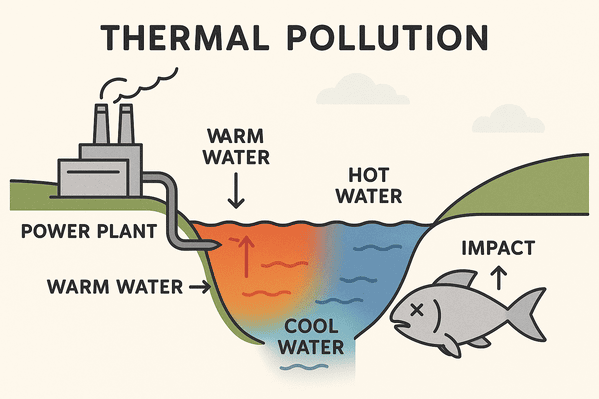
The Science Behind Water Temperature and Aquatic Life
Water temperature regulates nearly every aspect of aquatic ecosystems:
- Metabolic rates: Each species has evolved to function optimally within specific temperature ranges
- Dissolved oxygen capacity: Warmer water holds less oxygen (a simple physical property with devastating biological consequences)
- Breeding cycles: Temperature often serves as the primary trigger for reproduction in many species
- Migration patterns: Seasonal temperature changes guide movement and behavior
- Enzyme activity: Biological processes depend on enzymes that function within narrow temperature ranges
When we artificially alter these temperatures, we’re essentially rewriting the rules that aquatic life has evolved to follow over millions of years, often too rapidly for adaptation to occur.
Primary Sources Contributing to the Effects of Thermal Pollution on Aquatic Ecosystems
1. Power Generation Facilities
Power plants—particularly nuclear and coal-fired facilities—represent the largest contributors to thermal pollution globally. These plants typically use a “once-through” cooling system that:
- Withdraws cool water from rivers, lakes, or oceans
- Circulates it through condensers to absorb waste heat
- Discharge the now-heated water back into the source
- Can increase water temperatures by 8-12°C near discharge points
A single 1,000-megawatt nuclear plant can use up to 1.5 billion gallons of water daily, returning it at temperatures significantly above ambient conditions.
2. Industrial Manufacturing Processes
Many industries rely on water for cooling, processing, and cleaning operations, including:
- Steel mills and metal processing plants
- Paper and pulp production facilities
- Chemical manufacturing plants
- Food processing facilities
Unlike power plants, industrial discharges often contain other pollutants alongside thermal pollution, creating compound stressors for aquatic ecosystems.
3. Urban Heat Islands and Stormwater Runoff
In urbanized areas, impervious surfaces like roads, parking lots, and buildings absorb solar radiation and transfer this heat to rainwater that flows into nearby waterways. Studies have shown that stormwater runoff from urban areas can be up to 5-10°C warmer than runoff from forested areas.
4. Deforestation and Riparian Zone Destruction
The removal of trees and vegetation along waterways eliminates natural shade, exposing water surfaces to direct sunlight. This vegetation loss can:
- Increase maximum water temperatures by 2-10°C
- Create more extreme temperature fluctuations between day and night
- Reduce habitat complexity that normally provides thermal refuges
5. Climate Change Amplification
While not a direct source of thermal pollution, climate change amplifies its effects by:
- Raising baseline water temperatures globally
- Creating more frequent and severe heat waves
- Reducing water flow in many systems during the summer months when thermal stress is already highest
Devastating Effects of Thermal Pollution on Aquatic Ecosystems
1. Oxygen Depletion: The Silent Killer
The relationship between water temperature and dissolved oxygen follows an inverse relationship—as temperature rises, oxygen solubility decreases. This fundamental chemical principle creates a cascade of consequences:
- At 0°C, water can hold approximately 14.6 mg/L of dissolved oxygen
- At 20°C, this drops to about 9.1 mg/L (a 38% reduction)
- At 30°C, capacity falls further to around 7.5 mg/L (nearly 50% less than ice-cold water)
Many cold-water species like trout and salmon require minimum dissolved oxygen levels of 6-8 mg/L. When thermal pollution pushes waters above 25°C, these species face oxygen stress even if the water is at maximum oxygen saturation for that temperature.
A 2023 study published in the journal Environmental Science & Technology documented that fish kills attributed to oxygen depletion have increased by 32% in thermally polluted waterways over the past decade.
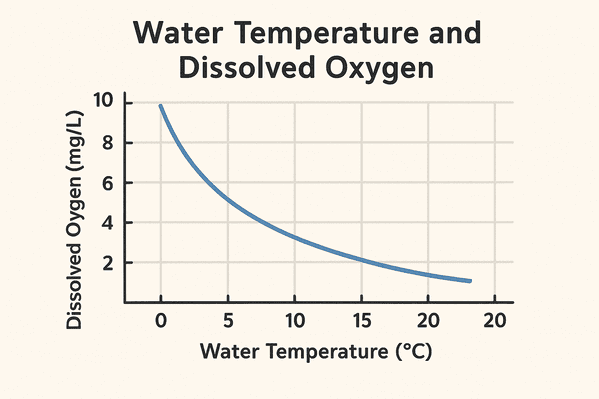
2. Metabolic Rate Acceleration
Thermal pollution forces aquatic organisms into physiological stress by:
- Increased oxygen demand:
- Ectothermic (cold-blooded) species’ metabolism speeds up as water warms
- Oxygen needs rise just as warmer water holds less dissolved O₂
- Energy imbalance:
- Animals must eat more to meet heightened metabolic demands
- Foraging efficiency often declines in warmer, oxygen-poor water
- Long-term consequences:
- Initial growth spurts may occur, but sustained heat reduces survival
- Immune systems weaken, increasing disease susceptibility
Example: A 2022 Nature study found that trout in warmed streams needed 30% more food to maintain growth, but prey availability dropped by 25%.
3. Reproductive Disruption and Population Collapse
Temperature serves as a critical timing cue for reproduction in most aquatic species. The effects of thermal pollution on aquatic ecosystems include disruption of these carefully evolved patterns by:
- Triggering spawning at inappropriate times when food resources for offspring may be unavailable
- Accelerating egg development, often producing less viable offspring
- Skewing sex ratios in species where sex determination is temperature-dependent (many reptiles and some fish)
- Creating thermal barriers that prevent migration to spawning grounds
Research on the Columbia River has shown that salmon experience a 50% reduction in spawning success when water temperatures exceed 18°C for extended periods.
Temperature vs. Dissolved Oxygen
| Water Temp (°C) | Max. Dissolved O₂ (mg/L) | Impact on Fish |
| 0°C (Ice-cold) | 14.6 mg/L | Ideal for trout/salmon |
| 20°C (Room temp) | 9.1 mg/L (-38%) | Stress begins for cold-water species |
| 30°C (Warm) | 7.5 mg/L (-49%) | Lethal to most sensitive fish |
Caption: As temperature rises, water’s oxygen-holding capacity plummets, creating a deadly squeeze for aquatic life.
4. Biodiversity Loss and Community Restructuring
As thermally sensitive species decline, more tolerant species fill the vacancy, fundamentally altering ecosystem structure:
- Cold-water specialists are replaced by warm-water generalists
- Native species may be displaced by invasive species adapted to warmer conditions
- Complex food webs simplify, reducing ecosystem resilience
- Specialist relationships (like specific predator-prey interactions) break down
The ecological principle of “competitive exclusion” becomes evident as warm-water species gain competitive advantages over cold-water natives that are now operating outside their thermal optimum.
5. Harmful Algal Blooms and Eutrophication
Elevated water temperatures, combined with nutrient pollution, create perfect conditions for explosive algal growth:
- Cyanobacteria (blue-green algae) growth rates increase exponentially with temperature
- Many toxic algal species thrive in warmer waters
- Algal decomposition further depletes oxygen, creating “dead zones”
- Water clarity decreases, reducing light penetration for beneficial aquatic plants
The economic impact is substantial—harmful algal blooms cost the U.S. economy an estimated $4.6 billion annually through damage to recreational water use, property values, and drinking water treatment costs.
6. Thermal Shock and Acute Mortality Events
Sudden temperature changes—often from periodic industrial discharges—can cause immediate death in aquatic organisms unable to escape. These thermal shock events:
- It can occur when temperature changes exceed 1-2°C per hour
- Primarily affects less mobile species like mussels, aquatic insects, and juvenile fish
- Often go undocumented when they occur in remote areas or outside regulatory monitoring
- May be especially destructive during sensitive life stages like spawning or larval development
Real-World Case Studies: Evidence of the Effects of Thermal Pollution on Aquatic Ecosystems
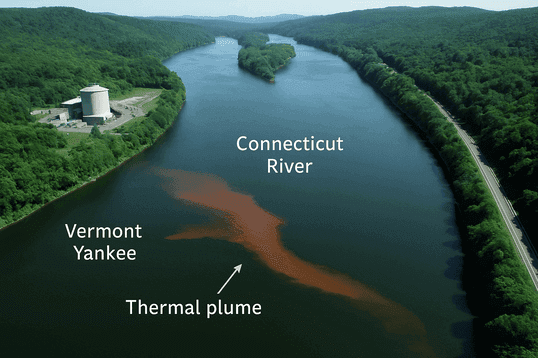
Case Study 1: Connecticut River and Nuclear Power
The Vermont Yankee Nuclear Power Plant operated on the Connecticut River for over 40 years before closing in 2014. Long-term monitoring revealed:
- Summer water temperatures near the discharge point averaged 5°C above upstream measurements
- Thermal plumes extended up to 3 miles downstream
- Native brook trout populations declined by 68% in affected areas
- Smallmouth bass (a warm-water species) increased by 412% in the same zones
Post-shutdown studies have documented partial ecological recovery, with cold-water species gradually returning to formerly impacted areas—strong evidence that thermal pollution, not other factors, drove the original changes.
Case Study 2: The Ganges River Industrial Corridor, India
Along a 100-kilometer stretch of the Ganges River, multiple industrial facilities and power plants have created compounding thermal impacts:
- Water temperatures in some sections remain elevated by 3-4°C year-round
- Dissolved oxygen levels routinely fall below 4 mg/L during the summer months
- Native fish diversity has declined by 45% since industrialization began
- Respiratory diseases among fish increased by 230% in the impacted zones
- Local fisheries have reported catch declines of 35-60%
A comprehensive study published in Environmental Monitoring and Assessment in 2022 directly correlated these impacts with thermal discharge points rather than other pollution sources.
Case Study 3: Urban Streams in Melbourne, Australia
Researchers comparing urban streams to nearby forested streams documented dramatic thermal differences:
- Urban streams averaged 3.8°C warmer than forest streams
- Maximum summer temperatures in urban streams often exceeded 30°C
- Sensitive macroinvertebrate species were absent from urban streams
- Algal biomass was 3-5 times higher in urban waterways
- Urban streams showed 60% lower fish species diversity
This case demonstrates how urbanization and thermal pollution interact to degrade aquatic ecosystems even without point source industrial discharges.
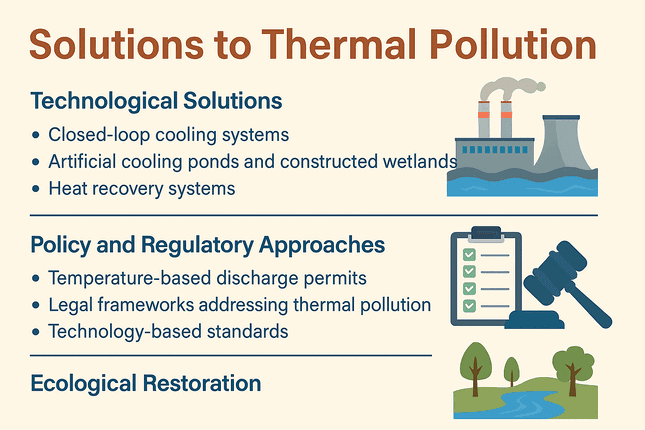
Comprehensive Solutions to Mitigate the Effects of Thermal Pollution on Aquatic Ecosystems
Technological Solutions
1. Closed-loop cooling Systems
Unlike once-through systems, closed-loop cooling recirculates water through cooling towers, dramatically reducing thermal discharge:
- Reduces water withdrawal by up to 95%
- Decreases thermal discharge by 98%
- Requires a higher initial investment but offers long-term ecological benefits
- Now mandated for new power plants in many jurisdictions
2. Artificial Cooling Ponds and Constructed Wetlands
These engineered systems allow heated water to cool naturally before release:
- Can reduce discharge temperatures by 3-5°C
- Provide additional wildlife habitat when properly designed
- Offer educational and recreational opportunities
- Can be integrated with existing industrial facilities
3. Heat Recovery Systems
Capturing waste heat for beneficial use transforms an environmental liability into an asset:
- District heating for nearby communities
- Industrial process heating
- Greenhouse agriculture applications
- Aquaculture operations are designed for warm-water species
A 2023 assessment by the International Energy Agency estimated that industrial waste heat recovery could prevent the equivalent of 1.3 billion tons of CO₂ emissions annually while reducing thermal pollution.
Policy and Regulatory Approaches
1. Temperature-Based Discharge Permits
Regulatory frameworks that specifically address temperature:
- Establishing seasonal temperature limits based on ecosystem needs
- Requiring continuous monitoring and public reporting
- Implementing mixing zone restrictions to prevent thermal plumes
- Creating thermal total maximum daily loads (TMDLs) for impaired waterways
2. Legal Frameworks Addressing Thermal Pollution
Several key regulations recognize thermal pollution as a threat to water quality:
- U.S. Clean Water Act (Section 316(a)):
- Requires power plants to demonstrate that thermal discharges won’t harm aquatic life.
- Mandates “best available technology” for cooling systems.
- EU Water Framework Directive:
- Sets ecological standards for surface waters, including temperature limits.
- Requires member states to prevent “thermal degradation” of rivers/lakes.
- India’s Environmental Protection Act (1986):
- Empowering regulators to set thermal discharge limits for industries.
Gaps: Many laws focus on industrial point sources, while urban runoff and cumulative impacts remain underregulated.
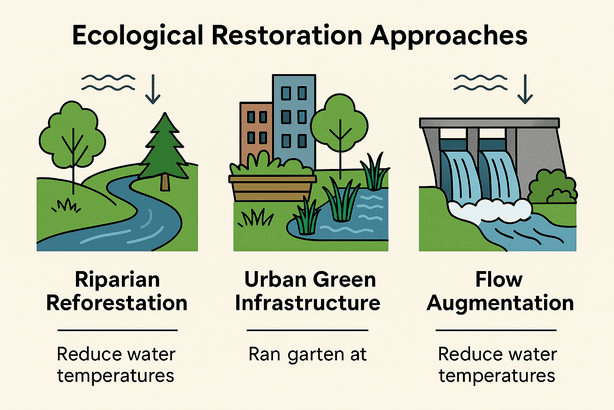
3. Technology-Based Standards
Requiring the best available technologies for new facilities:
- Mandating cooling towers or equivalent technologies
- Establishing phase-out timelines for once-through cooling
- Creating tax incentives for waste heat recovery
- Supporting research for innovative cooling technologies
4. Watershed-Level Planning
Addressing the cumulative impacts of multiple thermal sources:
- Establishing thermal budgets for watersheds
- Coordinating discharge timing among multiple facilities
- Preserving cold-water refuges through protected areas
- Integrating thermal considerations into broader water quality management
Ecological Restoration Approaches
1. Riparian Reforestation
Restoring streamside vegetation creates natural temperature regulation:
- Provides shade that can reduce water temperatures by 2-5°C
- Stabilizes banks and reduces erosion
- Filters pollutants from runoff
- Creates wildlife corridors and habitat complexity
A five-year study of stream restoration in Oregon found that replanted riparian zones reduced maximum summer water temperatures by an average of 3.6°C.
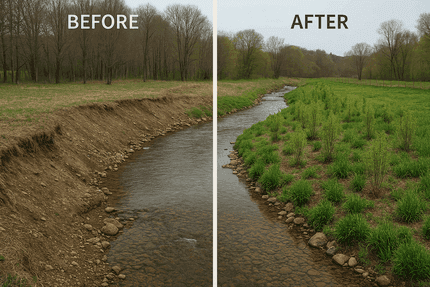
2. Urban Green Infrastructure
Reducing heat island effects through smart urban design:
- Permeable pavements that reduce heated runoff
- Rain gardens and bioswales that cool stormwater
- Green roofs that prevent heat absorption
- Urban tree canopy expansion programs
3. Flow Augmentation
Maintaining adequate water volume helps buffer against temperature increases:
- Strategic reservoir releases during critical periods
- Groundwater protection to maintain cold-water springs
- Water conservation programs to maintain ecological flows
- Removal of unnecessary impoundments that increase solar heating
How You Can Help Address the Effects of Thermal Pollution on Aquatic Ecosystems
Individual Actions
- Reduce energy consumption: Since power generation is the largest source of thermal pollution, energy conservation directly reduces thermal impacts
- Support riparian protection: Volunteer for stream restoration projects in your community
- Advocate for permeable surfaces: Encourage your local government to adopt permeable pavement requirements
- Plant trees: Participate in urban forestry initiatives that reduce heat island effects
- Stay informed: Monitor water temperatures in local waterways using citizen science apps
Community Engagement
- Support water quality monitoring programs: Volunteer with watershed organizations to help track temperature changes
- Attend public hearings: Speak up when new facilities apply for water discharge permits
- Educate others: Share information about the effects of thermal pollution on aquatic ecosystems with your community
- Support science-based policies: Advocate for temperature standards that protect sensitive species
Conclusion: Taking Action Against the Effects of Thermal Pollution on Aquatic Ecosystems
The effects of thermal pollution on aquatic ecosystems represent one of the most pervasive yet underappreciated threats to water bodies worldwide. As we’ve seen throughout this article, its impacts extend from molecular to ecosystem levels, disrupting everything from oxygen availability to food web relationships.
Unlike many other pollution types, thermal pollution is often completely legal, widely accepted, and subject to minimal regulation, despite its profound ecological consequences. This reality makes public awareness and advocacy especially important.
The good news is that effective solutions exist at multiple scales, from individual actions to policy reforms. By implementing cooling technologies, restoring natural thermal buffers like riparian forests, and adopting temperature-conscious water management, we can significantly reduce the effects of thermal pollution on aquatic ecosystems.
Remember: every degree matters in aquatic ecosystems. Your advocacy for temperature-conscious policies and practices can help ensure that our lakes, rivers, and streams remain vibrant, diverse ecosystems for generations to come.
Need a Summary or Quiz for Class?
📥 Download our free 👉 Download Thermal_Pollution_Effects_Student_Resources.zip with infographic, summary & mini-quiz
FAQs About the Effects of Thermal Pollution on Aquatic Ecosystems
Q1: What is thermal pollution in simple terms?
A: Thermal pollution happens when industries or power plants release heated water into rivers, lakes, or oceans. This sudden rise in temperature harms aquatic life by changing their environment.
Q2: Why is thermal pollution harmful to fish and other aquatic animals?
A: Hotter water has less oxygen, which makes it hard for fish to breathe. It also messes with their breeding cycles and can cause stress, diseases, or even death.
Q3: Can thermal pollution cause algal blooms?
A: Yes. Warmer water can speed up algae growth. Too much algae (called an algal bloom) blocks sunlight and uses up oxygen, harming other aquatic life.
Q4: What are some real-world examples of thermal pollution?
A: India: Power stations like NTPC release heated water into rivers.
USA: Power plants near the Great Lakes have affected local fish populations.
Australia: Mining and energy industries have altered freshwater temperatures.
Q5: How does climate change link to thermal pollution?
A: Climate change increases air temperatures, which heat water bodies naturally. Combined with human thermal pollution, this makes aquatic ecosystems even more fragile.
Q6. Is thermal pollution a global issue?
Yes. It affects rivers, lakes, and coastal waters worldwide, especially in countries with heavy industrial activity or weak environmental laws.
Want a Printable PDF quiz? Click here to download
Want to learn more about Thermal Pollution?
- 🌿 What is Thermal Pollution? Causes, Effects, and Solutions Explained
- 🐠 Causes of Thermal Pollution: Human vs Natural Sources
- 🛠️ Real-World Examples of Thermal Pollution in India
About the Author
Soumen Chakraborty is an environmental blogger and educator passionate about sustainability and hands-on learning. He creates practical guides and resources to help teachers, parents, and students explore eco-friendly activities and build a greener future together. When he’s not writing, Soumen enjoys nature walks, photography, and sharing simple ways everyone can protect the planet.
🌱 “Every small action matters in protecting our planet.”

